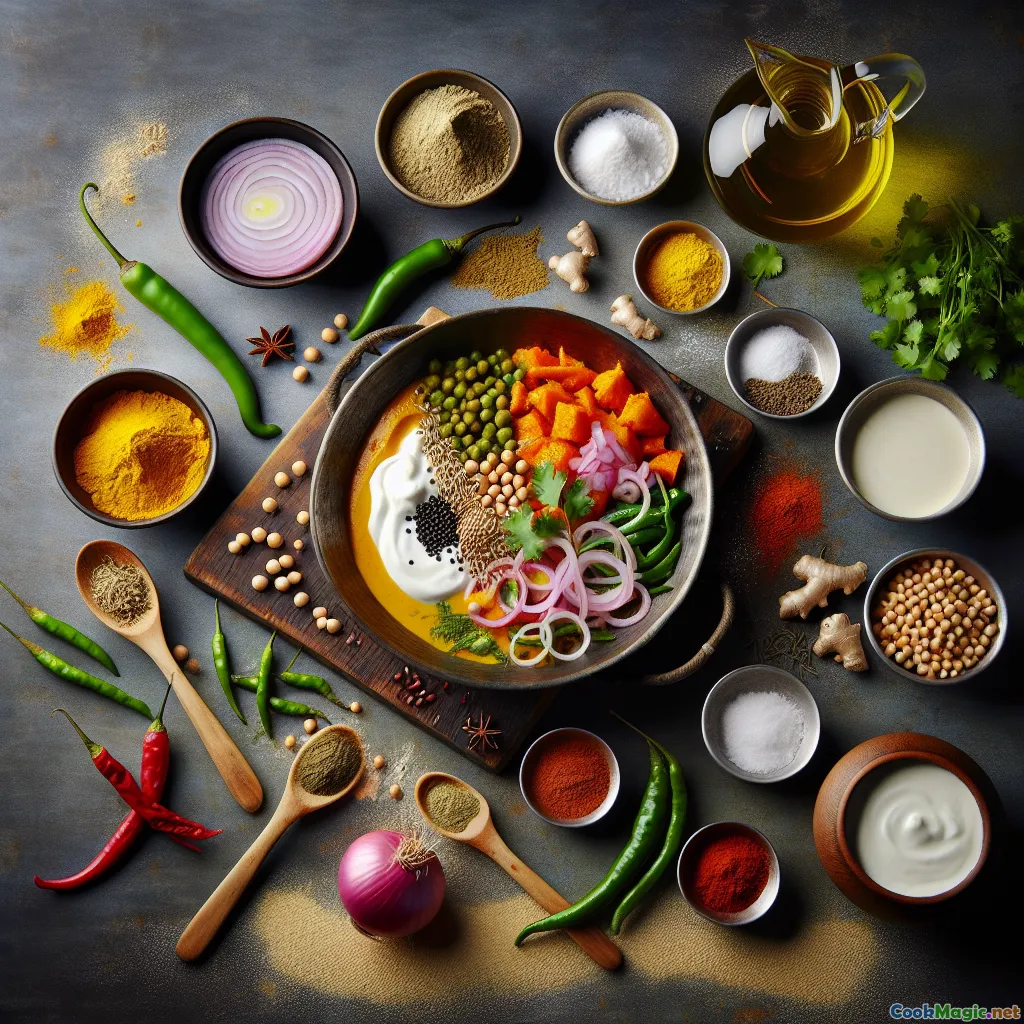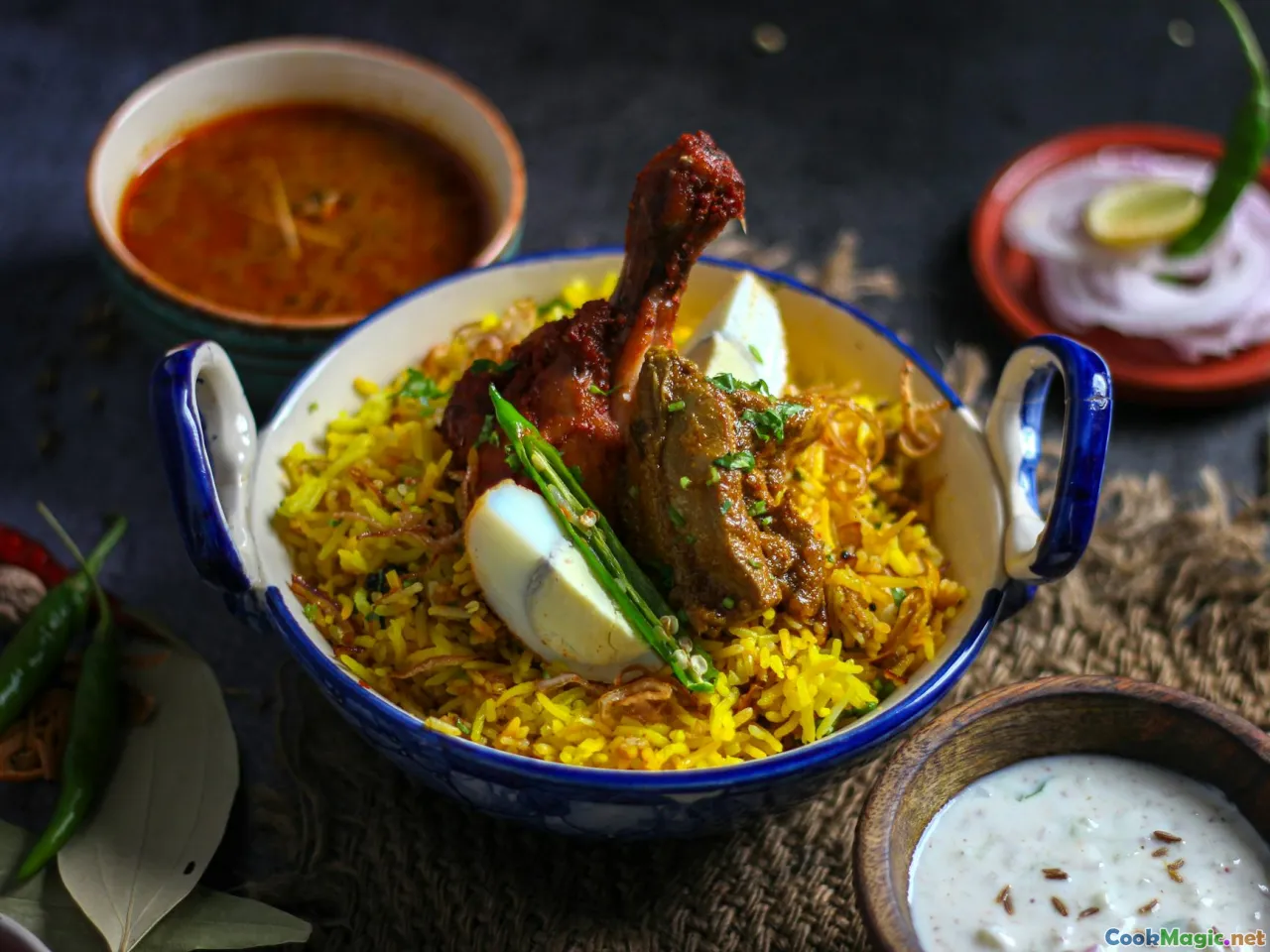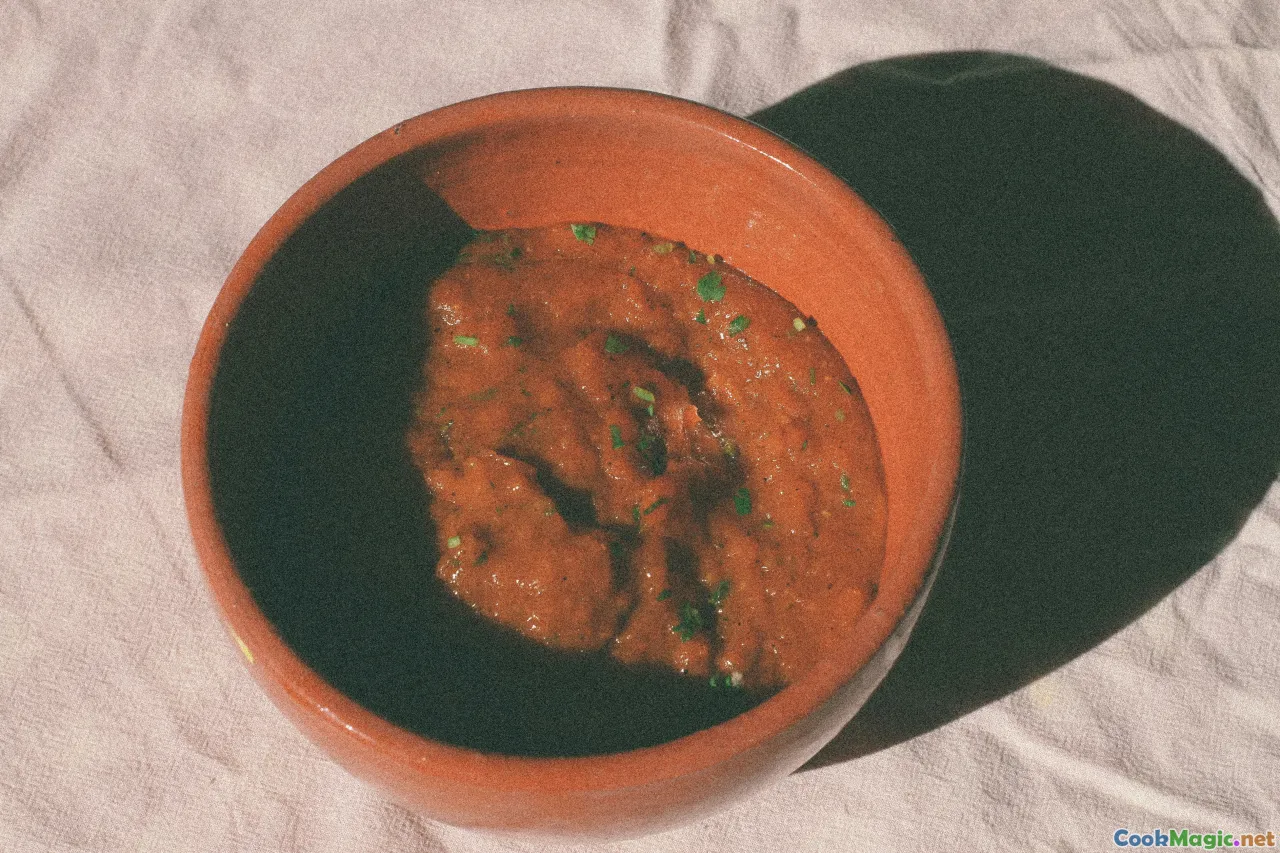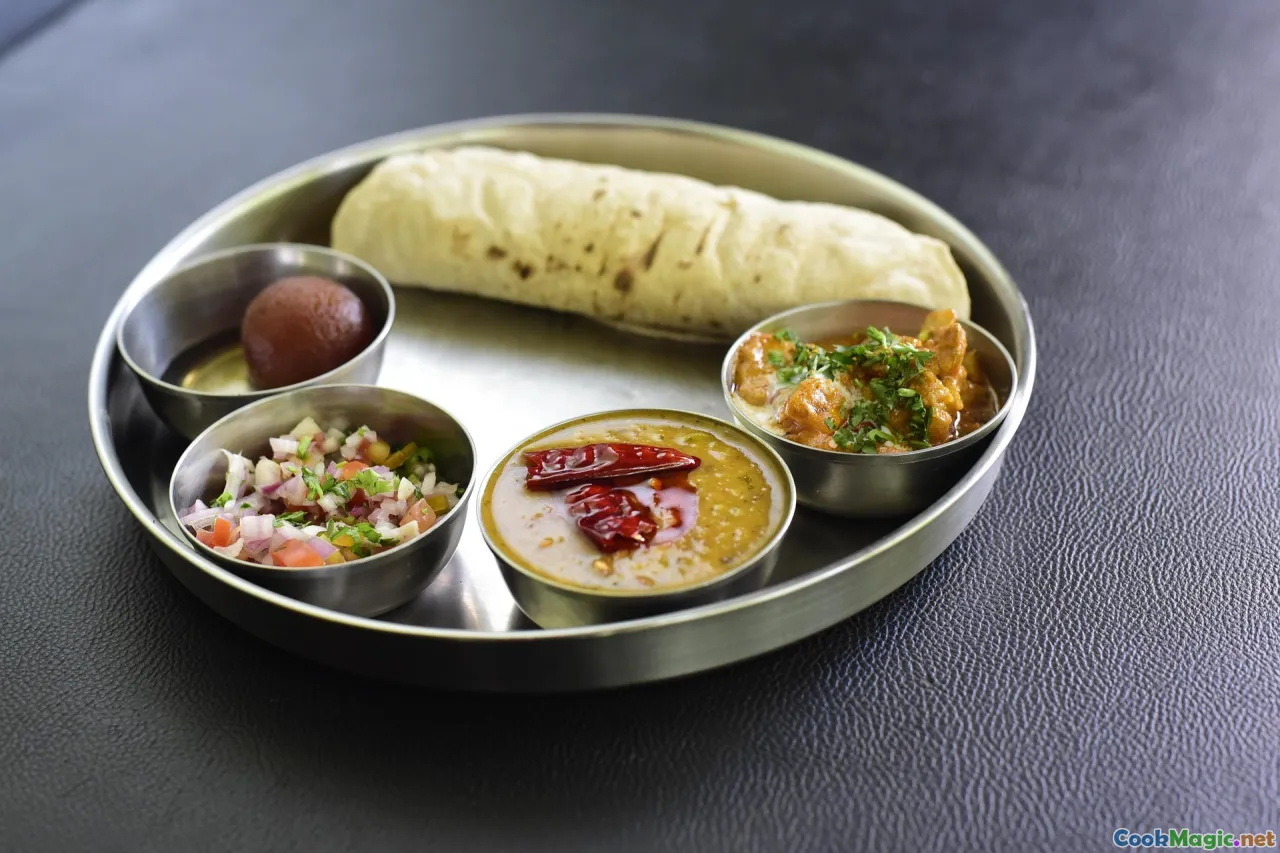
乡村印度风味的嘎特·基·萨布吉:香料鹰嘴豆丸子
(Rustic Indian Gatte Ki Sabzi: Spiced Chickpea Dumplings)
(0 评论)食材
-
1.5 cups 鹰嘴豆粉(Besan)
(Sifted for lumps)
-
1 cup 打发酸奶
(Use homemade if possible)
-
1 medium 洋葱
(切得很细)
-
1 tsp 姜泥
(新鲜磨碎)
-
1 small 青辣椒
(切得很细,根据口味调整)
-
0.5 tsp 姜黄粉
-
0.5 tsp 红辣椒粉
-
2 tsp 香菜粉
-
1 tsp 孜然种子
-
1 tsp 茴香籽
(轻轻压碎)
-
0.5 tsp 小茴香(车前籽)
-
1.5 tsp 盐
(按个人口味)
-
3 tbsp 油
(植物油或芥末油)
-
0.5 tsp 加拉姆马萨拉
(用作收尾)
-
2.5 cups 水
(As required for dough and gravy)
-
2 tbsp 香菜
(切碎,作为装饰)
(Sifted for lumps)
(Use homemade if possible)
(切得很细)
(新鲜磨碎)
(切得很细,根据口味调整)
(轻轻压碎)
(按个人口味)
(植物油或芥末油)
(用作收尾)
(As required for dough and gravy)
(切碎,作为装饰)
营养
- 份量: 4
- 每份大小: 1 碗 (250克)
- Calories: 330 kcal
- Carbohydrates: 0 g
- Protein: 14 g
- Fat: 12 g
- Fiber: 7 g
- Sugar: 4 g
- Sodium: 1050 mg
- Cholesterol: 5 mg
- Calcium: 110 mg
- Iron: 3 mg
制作步骤
-
1 - Make Gatte Dough:
Combine besan, half the salt, turmeric, red chili, coriander powder, ajwain, fennel seeds, ginger paste, 1 tbsp oil, and one-third of yogurt in a bowl. Mix and add water gradually until a soft, non-sticky dough forms.
-
2 - Shape the Gatte:
Divide dough into 4-5 portions. Roll each into cylindrical logs about half-inch thick.
-
3 - Boil Gatte:
Bring 4 cups water to a boil in a saucepan. Drop the dough logs in and simmer for 7-8 minutes or till they rise to the surface. Remove, drain, and slice into coins.
-
4 - Prepare Yogurt Mixture:
In a bowl, mix remaining yogurt with 1 cup water and a pinch of turmeric, whisking to avoid lumps.
-
5 - Make Curry Base:
Heat 2 tbsp oil in a kadai or heavy pan. Add cumin seeds and allow to splutter. Optionally add onions and green chili, sauteing until golden.
-
6 - Cook the Gravy:
Lower heat. Add yogurt-water mixture, stirring constantly to prevent curdling. Season with remaining salt, turmeric, red chili, dash of coriander. Bring to a simmer.
-
7 - Add Gatte and Simmer:
Add sliced gatte into the simmering curry. Cook 7-10 minutes so dumplings absorb curry flavor. Sprinkle garam masala near the end and adjust seasoning.
-
8 - Garnish and Serve:
Turn off heat. Garnish with chopped cilantro. Serve hot with steamed rice, jeera rice, or Rajasthani roti.
Combine besan, half the salt, turmeric, red chili, coriander powder, ajwain, fennel seeds, ginger paste, 1 tbsp oil, and one-third of yogurt in a bowl. Mix and add water gradually until a soft, non-sticky dough forms.
Divide dough into 4-5 portions. Roll each into cylindrical logs about half-inch thick.
Bring 4 cups water to a boil in a saucepan. Drop the dough logs in and simmer for 7-8 minutes or till they rise to the surface. Remove, drain, and slice into coins.
In a bowl, mix remaining yogurt with 1 cup water and a pinch of turmeric, whisking to avoid lumps.
Heat 2 tbsp oil in a kadai or heavy pan. Add cumin seeds and allow to splutter. Optionally add onions and green chili, sauteing until golden.
Lower heat. Add yogurt-water mixture, stirring constantly to prevent curdling. Season with remaining salt, turmeric, red chili, dash of coriander. Bring to a simmer.
Add sliced gatte into the simmering curry. Cook 7-10 minutes so dumplings absorb curry flavor. Sprinkle garam masala near the end and adjust seasoning.
Turn off heat. Garnish with chopped cilantro. Serve hot with steamed rice, jeera rice, or Rajasthani roti.
关于 乡村印度风味的嘎特·基·萨布吉:香料鹰嘴豆丸子 :的更多信息
Gatte Ki Sabzi: A Rajasthani Vegetarian Gem
Gatte Ki Sabzi is a truly unique vegetarian curry hailing from Rajasthan, a region known for its arid climate and rich, spice-laden cuisine. This dish beautifully epitomizes the innovation born out of scarcity—when vegetables are hard to come by, besan (chickpea flour) acts as the magic ingredient!
A Taste of Desert Heritage
Rajasthan has a deeply ingrained food culture, shaped by harsh summers and sparse water supplies. Dairy, dried pulses, chickpea flour, and a fabulous bouquet of dried spices come together marvelously in recipes like Gatte Ki Sabzi. Because fresh vegetables are often not available in desert regions, Rajasthani homemakers ingeniously create flavorsome "gatte" by binding chickpea flour and aromatics into dough, boiling, slicing, and simmering in a yogurt-based curry.
Nuances and Tips
- Avoid Curdling: One of the keys to success is to add the yogurt over medium-low flame, stirring continuously. This guards against curdling and makes for a silky curry.
- The Right Gatte Texture: The dough should be soft yet firm. If too sticky, add a touch more chickpea flour; if dry, a few drops of oil or water help.
- Infusions: Adjust spices according to preference. Some love more fennel or chili for depth.
- Serving Suggestions: Traditionally enjoyed with bajra (pearl millet) rotis or steamed rice. For a gluten-free meal, this pairing is perfect.
History & Culture
The recipe’s East-meets-West unique aspect is its complete reliance on pantry staples. Gatte translates to dumplings or bites. The sabzi refers to the yogurt-spice curry that makes this so inviting—warm, tangy, and full of soul.
Gatte Ki Sabzi isn’t everyday fare even in Rajasthan; it’s considered special enough for festivals, weddings, or guests. The protein and fiber content from chickpea flour, plus the probiotic advantage of yogurt, make it nourishing and easily digestible (perfect for vegetarians, vegans - if a non-dairy yogurt is used).
Personal Thoughts
I find Gatte Ki Sabzi to be one of the most rewarding curries for home cooks looking to expand their vegetarian repertoire. The process is relaxing and tactile: mixing the dough, gently boiling the gatte, then letting them infuse in the curry. The aromas are heady, inviting the senses to a dish that's both comfort food and celebratory feast.
As a serving suggestion, sprinkle the top with a squeeze of lime and plenty of chopped green coriander leaves. You could even toss in kasoori methi (fenugreek leaves) for layered flavor. To reheat, add a splash of water so the curry remains luscious.
Most importantly, Gatte Ki Sabzi epitomizes that magic combination: humble ingredients, bold flavor, and deep cultural connection. Try this recipe next time you wish to travel—culinarily—to the Rajasthani deserts, no passport required!
























